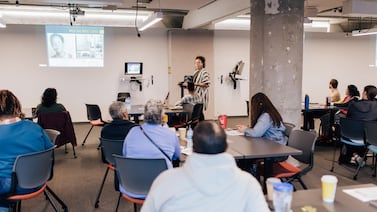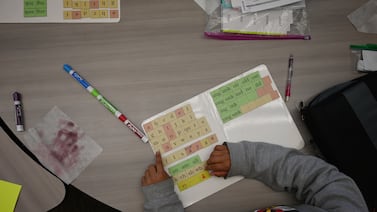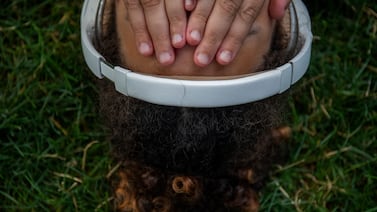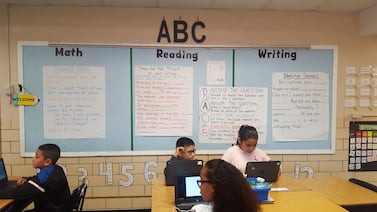Sign up for Chalkbeat Chicago’s free daily newsletter to keep up with the city’s public school system and statewide education policy.
Jianan Shi describes himself as “an immigrant that’s fallen in love with Chicago.”
Born in China, he immigrated first to Toronto at age 5 and later to Boston at age 8. Raised and later adopted by his aunt and uncle, Shi said he was undocumented until age 16 and was “very much in the shadows as a kid,” always fearful of being deported.
Shi moved to Chicago in his twenties and taught at Solorio Academy High School.
“One of the reasons I think I love Chicago is I got to choose Chicago,” Shi said.
Now, Mayor Brandon Johnson has chosen Shi, 33, to be president of the Chicago Board of Education. He’s the first Asian American and youngest person in recent memory to hold the high-profile appointment to oversee the city’s largest sister agency and the state’s second largest employer. Previously, he served as the executive director of the parent group Raise Your Hand, though he’s not a parent yet himself.
When Shi reflects on his own education, he said he thinks a lot about access and opportunity. As an English learner, he developed a love of books early on and remembers getting extra reading support and sneaking “a few more books” than the three each student was allowed from the library, which he noted was staffed with a full-time librarian.
Shi sat down for an interview with Chalkbeat Chicago this week wearing a blazer and a T-shirt from the Solorio DREAM Team, a club for undocumented students advocating for immigrant rights, with a colorful butterfly and the saying: “Fear only limits your dreams.”
This interview has been lightly edited for length and clarity.
You’ll likely be the last school board president on a fully-appointed Chicago Board of Education. Are there policies or practices you’d like to implement in the next two years before the shift to a hybrid and later elected school board?
It’s been 42 days so far, and I have 505 left. I feel the urgency of this work. Part of the reason why I accepted this role was to help transition us towards a fully elected school board. I think some folks in Chicago lack the imagination that we can have expanded democracy, right? I know, it’s gonna be messy, but it needs to be iterated on. We’re already meeting with the board staff to look at different structures.
The previous board, especially Vice President Elizabeth Todd Breland, has been doing work around that. The Agenda Review Committee is one way to start being more transparent. We’ve stood up the Special Education Committee. A lot of it is setting the tone of how a board should act. We should be in community, and we should be communicating publicly, way more than before. I think there’s a lot of work to do around training to make sure board members are ready. This is a $9.4 billion institution with lots of moving pieces.
Do you envision the 21-member Board of Education almost like a mini Chicago City Council?
I don’t know how often we’ll have all 21 folks in full agreement. I think that’s the beauty of democracy and discourse, right? We’ll get a chance to really have tough conversations in public and together. There aren’t many models for a 21-member school board and so the board staff has done a lot of work. And I’m hopeful that we can also work towards a way where these positions are compensated.
The board announced in July it would meet on the last Thursday of the month instead of Wednesday to not conflict with City Council meetings. Last week, the board set the time and date of its next meeting to be in the Austin community on the West Side and in the evening. Previous boards have done that, but only as a sort of one-off event. Are you committing to doing that regularly?
We’ve already committed to three — one in the Austin community in September, one at Kennedy High School, and another we’ve committed to the south side. I believe it’s almost every quarter we’re doing it. I hope that we continue that. We want to, again, set the culture and tone so that when the new school board gets elected, they understand that it’s our role to be out in the community. I also hope to do office hours in the community.
Chicago is now the nation’s fourth largest school district and has lost about 80,000 students in the past decade. As board president, how do you plan to grapple with the declining number of students enrolled in CPS?
I want us to shift from looking at lagging indicators, and move towards how we invest in communities. If we provide well-resourced neighborhood schools, if there’s abundant social services and affordable housing in Chicago, those communities will grow back, right? I am maybe stubborn enough to believe that an institution like ours, and all of our sister agencies cannot be influential in the population in Chicago.
I think we need a comprehensive plan, from pre-K to 20. And what does that look like in your neighborhood and region? If I send my kid here, I know that they’re going to do pre-K to 8 here, there’s gonna be a great high school nearby that has the programs that I want to see my kids in, and then also access to community college and higher ed or jobs. That’s what we need to tell parents. That you can choose any neighborhood and you will find a path.
Chicago is seeing an influx of migrant students. It’s not clear if all schools have enough bilingual staff, the enrollment process is not quick, and there have been reports of migrants being turned away at some schools. There are volunteers, union staff, and district officials working to enroll children. But what more, if anything, can be done to streamline that process, as potentially more buses show up?
It’s not “if.” More buses will show up. And it’s intentionally chaotic, right? It’s intentionally disruptive … Chicago should be a sanctuary city, but there are so many challenges in making sure our newcomers’ needs are met.
It’s about food, shelter, and education. We’ve enrolled, I think 1,700 (students) in the last two months, and we’re enrolling 1,000 more. We’ll be strategic about placing them in schools where they’re best fit. But then these are also folks who are STLS (Students in Temporary Living Situations). I think we have 15 shelters in the city, but that’s not a permanent solution. So how are we looking towards housing? I know that’s starting to go outside of what is in my purview. Some folks tell me to stay in my lane, quote, unquote, but then we’re not actually addressing those students and families (needs).
Last fall, a report required by the law creating an elected school board outlined several costs the Board of Education may take on as it becomes more independent from City Hall. This could exacerbate financial problems for the school district. What is your plan for sorting out the financial relationship between the board and the City of Chicago?
That’s part of the transition towards the 21-seat school board: How do we create working relationships? The city understands in order for it to succeed, the education system needs to succeed. There’s a lot to look at and I think this is just the beginning of the conversation. I’ve read both reports. Ultimately we need more revenue. We’re woefully short from the federal government, from the state government. I think that’s where my focus is.
The deadline to spend down federal COVID recovery money is next fall. There are a number of initiatives, such as the CPS Tutor Corps, expanded summer school, and additional staffing, including academic interventionists and social workers, that have been supported with this money. What happens when that money runs out?
When I think about that question, I often get, I don’t know, a little upset. Because wealthy communities never have to make that choice. Schools in the suburbs do not have to make that choice. What I appreciated about being on Mayor Johnson’s transition committee, is that we tried to shift out of a scarcity mindset and think about what students need.
The federal government provided us money that allowed us to hire these interventionists and allowed us to hire staff for after-school programs. These aren’t just good to have for students. These are essentials. And we need to maintain those.
To be honest, the amount of ESSER money we got doesn’t even meet the gap that we are owed from the state. And that’s a formula that says all the things that we need. Yes, we need to look at how money is allocated and reduce waste. But again, it’s my job as board president to build a coalition of folks that work towards increasing revenue for Chicago Public Schools at every level. Before January, I intend on meeting with every elected (official) that touches Chicago.
Wow, that’s a big task.
It is a lot. But I think it’s clear to me that one, I want to listen because they also hear from schools and their needs. But it’s important to know that the whole state needs more revenue. There’s a lot of things that we can work together on whether it’s transportation or early childhood. But the evidence-based funding formula is obviously a big one. We’re still owed a billion dollars from the state on that alone.
Are you going to advocate for any changes to the 2021 law that created the 21-member elected school board for Chicago?
I think that’s a collaborative conversation. The Chicago school board will be voting on a legislative agenda in January that we will all abide by and all advocate for. It’ll be the first time ever, so leading up to that we are having those discussions.
Again, I personally do believe that board members should be compensated. As a former immigrant, I obviously believe that non-citizens should have the right to vote and that was recommended by the transition committee. But that’s a long process. I want to make sure that folks feel safe doing that and there’s the structures and systems in place. It’s not just a snap of a finger. I think there’s also stuff around eligibility that needs to be examined.
The previous board approved a smaller-than-usual capital plan in June and Mayor Johnson said a supplemental plan would come later this year. Chicago Public Schools has not had a Master Facilities Plan since 2018 and in the past, many school construction decisions were made behind closed doors. Many school buildings are old and in need of repairs or updates. How will the new school board approach capital planning?
Let’s just say I’m eager to work with the district on a comprehensive facilities plan that actually looks at how we want our buildings and programs to look in the next 10 years. There’s a lot of data that’s still being collected. And then we are going out to the community in the fall. I don’t think dates are set yet, but we made it very clear to management that something like this requires lots of community engagement around what we want to do with our buildings, what programs you want to see in neighborhoods, and again, how do we rebuild this idea of neighborhood schools, feeder networks, where there are rich programs.
There’s going to be an emphasis on Sustainable Community Schools. In these 42 days, what I’ve understood about Sustainable Community Schools is I think everyone supports them, they just don’t know it yet. Who doesn’t want wraparound programs? Who doesn’t want deep, authentic community engagement, and culturally relevant curriculum? Those are all things that I think every school wants. How do we work towards that?
And the goal is to have 200 Sustainable Community Schools by the end of the mayor’s first term, right?
The education transition committee report said 200. I think the appetite is to expand. But I want to make sure we do it right. That we serve students. Sustainable Community Schools haven’t really had consistency to thrive with a pandemic and everything. I went to three schools on my first day, and they said it was a game changer, a lifesaver. They have additional staff, restorative justice, and a trauma coordinator. It’s all these great things that make a school whole. It’s what makes students feel like they are ready to learn. And what ultimately has parents send them to those schools, right?
Becky Vevea is the bureau chief for Chalkbeat Chicago. Contact Becky at bvevea@chalkbeat.org.








